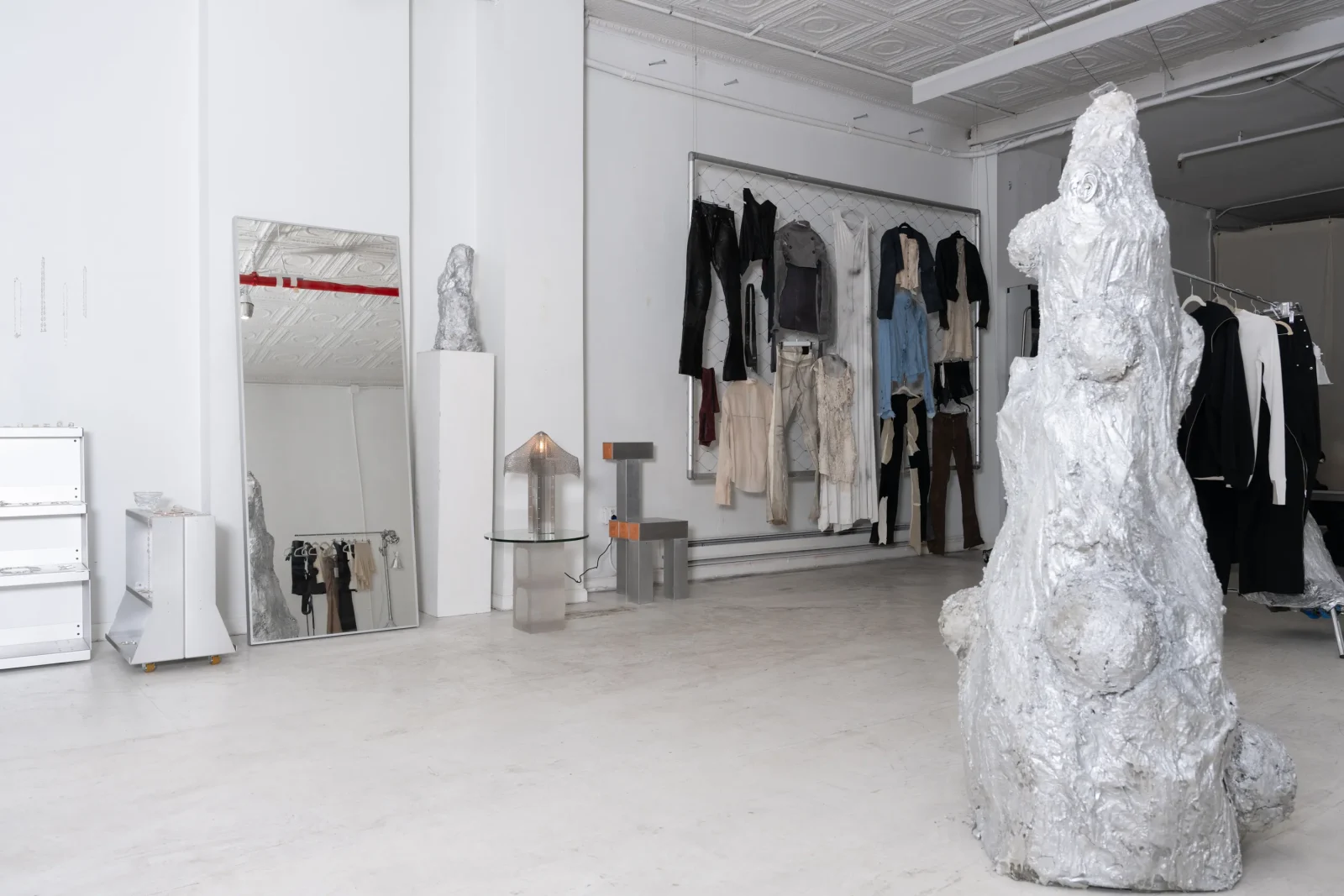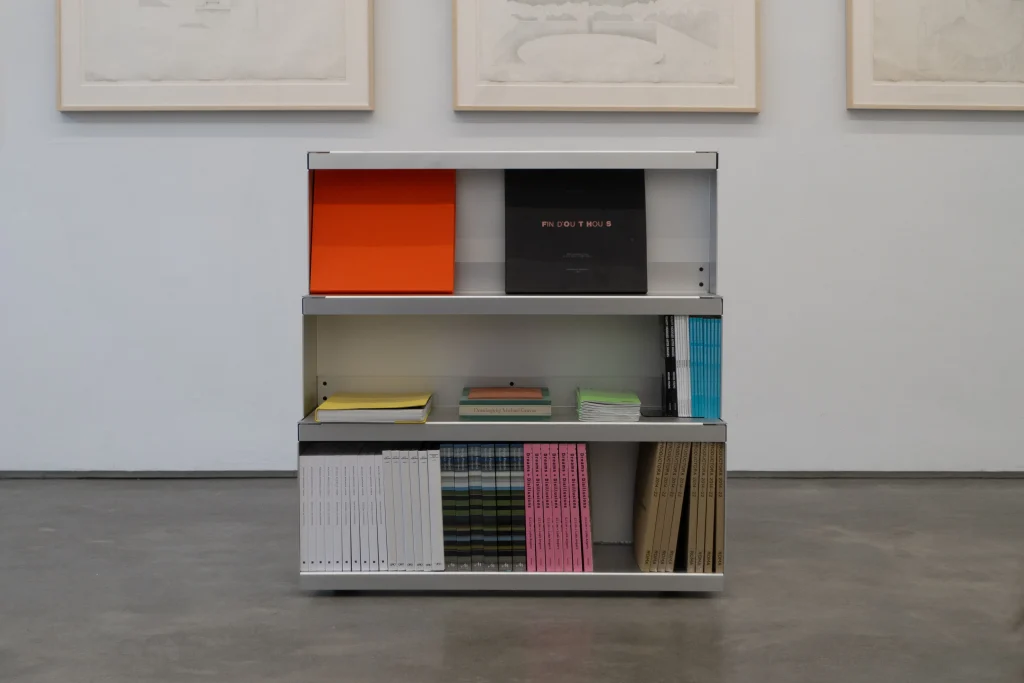
“An Irregular Future”: The Netherlands at Adorno London 2021
“To us, [Designing Futures] is about reflecting on the future, it’s about looking at both the positive and negative scenarios around us. Whilst many designers are very conscious about their choice of materials and processes, the world around us continues with greed and selfish choices which may not be best for society or the planet.“
– Rive Roshan, curators of the Dutch collection, “An Irregular Future”
“An Irregular Future” is part of Adorno London 2021, presented during London Design Festival, 18-26 September. Visit the collection at the Truman Brewery, Gallery 4 – Dray Walk, off Brick Lane, London, E1 6QL – 22 – 26 September 2021, 10.00-18.00. “An Irregular Future” is kindly supported by Embassy of the Netherlands in the UK.
From above, light spills into this enclosed space, illuminating richly textured concrete, objects displayed on plinths and hung on walls, and the still liquid concealing the floor below. With one step, a ripple of movement is released and the oil that fills the room laps at our ankles and up the walls. Light shifts in the skylight above, drawing its spotlight to a new point in the space, bringing our attention to the glass, wood, textile, stone, and sand around us. Moving deeper into the room, we note that the objects reflect the sense of fluidity beneath us with their undulating, irregular forms and reflective surfaces. Confined in this moment of natural versus industrial, hope versus doubt, we are compelled to contemplate the past and its role in our future.
Curated by design studio Rive Roshan, the Dutch collection, “An Irregular Future”, rejects the over-simplification and standardisation of design in favour of irregular objects and unfamiliar uses of materials. The collection reflects on the possible outcomes of the future through objects that appear familiar, yet their makers’ methods of creation and approaches to materials have been turned on their head, leading to pieces with new purposes and functions. Blown glass slumps over steel; sand is 3D printed to create a reflective, mirrored surface; carved out knots bring attention to the natural form of wood; a glass lamp is held high by its stone base; intricate, tactile patterns are detailed in textile; and optical lenses take on new life. The six designers presented here question the status quo and, through their “irregular” work, provide a new perspective for the future of collectible design.
“An Irregular Future” features work by Geke Lensink, Jesse Visser, Object Density, Rive Roshan, Sho Ota, and Studio Thier and van Daalen.
An Irregular Future
What are the main themes present in “An Irregular Future”?
The main themes in the selection of objects are irregular or unfamiliar uses of material. Stones as lights, sand as mirrors, wood that has been carved away to bring back the branches of the tree. All familiar materials which we are used to seeing and experiencing in our daily lives, but with a new purpose and function. We love to see the contrast between the natural and the industrial. All the designers and works in the curation play with this idea.


What is the significance of the oil-filled, brutalist concrete landscape that your collection is presented in?
We wanted to create a stark contrast with the soulful and natural-feeling materials, which feel pure and innocent because of their materiality and processes. The oil-filled concrete shell is a symbol of our ignorance and arrogance for the earth. It has a stark beauty whilst having a dark and eerie connotation reflecting many of the environmental discussions about climate change happening around the world.


How would you describe the contemporary design scene in the Netherlands?
We feel there are many social discussions occurring in the work of Dutch designers. The work is often based on a commentary rather than aesthetics as a starting point. In general, designers are looking for a progressive future.
Last year’s Dutch collection, “The Healing Collection”, explored the role of makers in the process of healing the planet, society, and the self. Drawing on similar themes, in what ways does “An Irregular Future” respond to or elaborate on this previous collection?
Last year’s collection was created during a time where the whole world was in shock and needed to find a new rhythm and way of living. Many things around the world were happening at the same time whilst everyone was locked down inside. It felt like a time for reflection and collection. The pieces all dealt with themes relevant at the time, which are not so irrelevant now. The shapes were quite harmonious, geometric, and in a way symmetrical. This year’s collection has a darker tone and atmosphere, it is more focused on the response to the planet. We are in a space with no entrance and no exit, the only source of light and visibility of a world beyond is from circular holes cut out of the ceiling, allowing light to flood the works. The floor is filled with oil. The space is a more dystopian reality of how our world could look if we do not take care of it. The pieces within are fluid, often irregular in form, or reflecting their surroundings.


As designers yourselves, what impact do you think a slower, more “irregular” approach to design will have on designers and the Dutch design scene itself in the future?
We own less, but cherish more. We spend our money on things we treasure rather than wanting lots of things. I think this is something already visible in the Dutch mentality and design scene. An irregular approach could also reflect the idea of consciously not following the norm, looking for something different or new that no one has ever heard of, rather than looking to show big names or brands that everyone knows. There is so much talent out there and the works being produced are often of a higher quality and level of uniqueness.
How do the pieces in your collection relate to the theme of Adorno London 2021, “Designing Futures”?
We responded quite directly to this theme. To us, Designing the Future is about reflecting on the future. It’s about looking at both the positive and negative scenarios around us. Whilst many designers are very conscious about their choice of materials and processes, the world around us continues with greed and selfish choices, which may not be best for society or for the planet. We would like to see what would happen in the future if the thoughts and ideas of the contemporary designers would have an impact on large corporations and decision makers.


What do you think the future has in store for contemporary design in the Netherlands?
There is a lot going on in the contemporary design scene in the Netherlands, with multiple platforms and events supporting emerging designers with new ideas and visions. We feel there is also a lot of support for innovation and that designers will look to translate their ideas into real-life, ‘free thinking’ solutions.
Meet Rive Rosan, curators of “An Irregular Future”
Rive Roshan is the artistic practice of Ruben de la Rive Box and Golnar Roshan. The studio creates to connect with people intuitively through exploring visual wonder as a means to emotional well-being.
“We feel our role as artists and designers is to offer people a new and inspiring narrative to build a progressive future ”
Through experimental processes the studio designs immersive spatial experiences, materials and objects that enrich lives and create memories that we treasure. Rive Roshan’s work has been on show at Les Musée des Arts Decoratifs Paris, The Old Selfridges Hotel London, Powerhouse Museum Sydney, Shanghai Museum of Glass, Museum JAN with a recent acquisition by National Gallery Victoria.
A deep interest in colour, texture and materiality leads to an aesthetic of raw beauty.
Can you give a bit of insight into your approach to curating this collection?
We curate from a theatrical and narrative-driven stand-point. We like to bring work together that is individually poetic and soulful and that comes together with other pieces to tell a larger story. We feel our role as curators is to be aware of the socio-political and cultural climate and often respond to these influences (although often discreet in execution).
If the viewers of “An Irregular Future” could take one concept or piece of information away from it, what would you want that to be and why?
Surround yourself with beautiful objects which trigger the heart and make you think about the future you want to live in…
“An Irregular Future” is kindly supported by:















